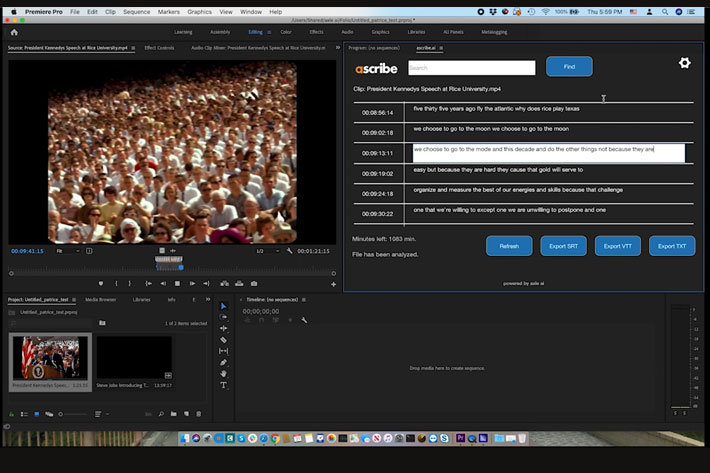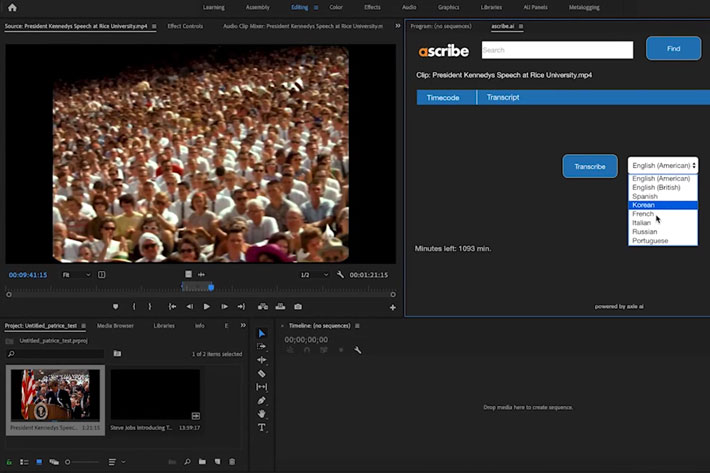
Launching at Adobe MAX Conference, the new ascribe.ai from axle ai is a leap forward for fast, accessible transcription delivered directly in Adobe Premiere Pro.
In keeping with Adobe MAX’s theme of Creativity For All, ascribe is axle ai’s first product to feature a freemium pricing model. Ascribe.ai is available from the Adobe Exchange Application Marketplace and from the ascribe.ai website at no charge, and includes one hour of free transcription of video content on registration. Subscriptions begin at $4.95 per month for 2.5 hours of transcription ($1.98 per hour), and even lower per-hour prices in larger quantities. Languages supported in the initial release are English (both American and British dialects), Spanish, French, Italian, Portuguese, Russian and Korean.
Rather than sending the entire video file to be transcribed, ascribe.ai creates an audio-only file that it quickly uploads in the background, obtaining and displaying the transcript as well as pushing all relevant markers to the timeline in Adobe Premiere Pro. According to axle ai, the whole process happens faster than realtime; each minute of footage can be transcribed and results returned to Premiere in as little as 10 seconds. Transcribed text appears as markers in the Premiere Pro timeline, as well as in sidecar XMP files made by ascribe.ai which contain the transcripts. Users also have the option of exporting an industry-standard SRT or VTT file with the transcript as well.

Adobe’s Creativity for All
Ascribe.ai uses the same axle Speech services used by the company’s axle ai 2019 media management system for small and midsize video teams. However, unlike axle ai 2019, the software is free and no centralized database or shared network storage is required. Ascribe.ai runs directly on any Mac or Windows system running Adobe Premiere Pro and connects with axle ai’s Speech cloud service via nearly any connection to perform the transcription.
Sam Bogoch, CEO of axle AI, said “Since our company was founded in 2012, we’ve made it our mission to bring the power of video search to an ever-wider group of creative teams. Now, with ascribe.ai, we’re taking it to a whole new level – the broader universe of freelancers and videographers who may work on their own, or on distributed teams. While these folks may not need our higher-end solutions yet, we thought it would be a great opportunity to make the power of AI-driven transcription available to everyone.
“We’ve been working on the technologies behind ascribe.ai for several months, including our axle Speech cloud service and the axle ai User Portal that manages subscriptions. Adobe is focusing on Creativity for All at this year’s Adobe MAX; we thought the timing was ideal, and great timing for us to roll out this new product which meets the needs of millions of Adobe Creative Cloud users, not only video teams who have had the benefit of our technology on their corporate networks.”
Transcription prices
“Premiere Pro is the industry leader for editing everything from feature films, TV series and beyond,” said Sue Skidmore, head of partner relations for Adobe Video. “ascribe.ai makes fast and efficient AI-driven transcription of videos accessible to all Adobe Premiere Pro users.”
The free ascribe.ai panel is available immediately from the ascribe.ai website, and soon from the Adobe Exchange Application Marketplace. Each instance includes free transcription of 1 hour of video/audio or audio-only content; subscriptions begin at $4.95 per month for 2.5 hours of transcription ($1.98 per hour), and even lower per-hour prices in larger quantities. Additional hours can be purchased from axle ai’s User Portal in blocks of 10 hours ($19.00) and 100 hours ($170.00).
The company says that “these prices, made possible by axle’s AI-powered axle Speech cloud service, compare very favorably with prices of other transcription services which range from several dollars per hour, to up to $1.00 or more per minute. Languages supported in the initial release are English (both American and British dialects), Spanish, French, Italian, Portuguese, Russian and Korean. More languages will be supported in the future.”

